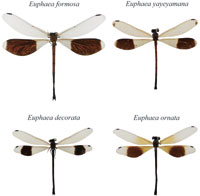We have moved to a new server!
Since March 2014, this website has been moved to this new server: http://web.ntnu.edu.tw/~treehopper/. This page will not be updated anymore. Please update your browser’s bookmark or the web links.
Member list
Current members
- Jo-Fan Wang
- 1. The Territorial Behavior of Euphaea formosa (Odonata). 2. Tempo and Mode of Pronotal Evolution in Membracis Treehoppers.
- Hung-Nien Chen
- 1. The effect of typhoon on survivalship of Matrona cyanoptera. 2. Modes of phenotypic variation in Euphaea amphicyana.
- Lan-Wai Yeh
- Ecology and evolution of Taiwanese Carabus ground beetles.
- Yun-Chieh Cheng
- What do damselfly larvae eat? DNA barcode analyses of larval diet in Matrona cyanoptera and Euphaea formosa.
- Chung-Hsin Huang
- Flucuating Asymmetry and Developmental Asymmetry of Cyclommatus mniszechi.
- Hui-Yun Tseng
- 1. Biological function of coloration in Pachyrrhynchus tobafolius. 2. Phylogeny and color evolution of Pachyrrhynchus weevils. 3. Population genetics of Pachyrrhynchus weevils on Lanyu and Green Island.
- I-Ting Hsiao
- Variation of genitalia in Euphaea amphicyana.
- Yen-Ting Chen
- The effect of forest management of Mt. Da-Shiue on the morphological variation of a ground beetle, Carabus (Apotomopterus) masuzoi.
- Jyun-Huei Huang
- The fighting behavior of a stag beetle, Rhaetulus crenatus.
- Shi-Ting Wu
- Membracis Phyllotropis.
- Chiao-Wei Lin
- The fighting behavior of a stag beetle, Rhaetulus crenatus.
- Yong-Chao Su
- Behavioral ecology, sociobiology, population genetics, and molecular phylogenetics.
Past members
- Wei-Liang Xiao
- Variation of wing veins in Euphaea amphicyana.
- Li-Wen Weng
- Why do firefly larvae emit light?
- Yat-Hung Lee
- Che-Yu Kuan
- Variation of mandibles in stag beetles.
- Chu-Yen Cheng
- Phylogeography of a Philippine's treehopper, Leptocentrus reponens.
- Ming-Yu Chen
- Phylogeography and population history of the treehoppers, Centrochares horifficus from the Philippines Archipelago.
- Shao-Chang Huang
- Visual Communication of Matrona cyanoptera
- Jen-Pan Huang
- Population Genetics and Phylogeographic Analyses of Formosan Damselfly, Euphaea Formosa (Insecta: Odonata: Euphaeidae) from Taiwan
- Wei-Yun Chen
- Molecular and Phylogenetic Characterization of Endosymbiotic Bacteria of the Froghopper, Okiscarta uchidae (Insecta: Hemiptera: Cercopidae)
Visiting scholars and students
- Vanitha Williams
- Predatory potential of waterbug, Diplonychus rusticus and dragonfly, Diplacodes trivialis on mosquito larvae.
- Marina Vilenica
- Dragonfly composition (Insecta, Odonata) in wetland area of Turopolje region, Croatia
- Klaas-Douwe 'KD' B. Dijkstra
- History, diversity and identification of dragonflies and damselflies (Odonata).
- Erin McCullough
- " Diversification of weapon form: aerodynamic costs of beetle horns.
- Ashley E. King
- Intrasexual combat and intersexual antagonistic co-evolution in horned beetles.
Yat-Hung Lee

Title
Master student 2007-2011
Species: Euphaea spp.

Project
Speciation of Euphaea damselflies.
Abstrct
E-mail:sr74425@hotmail.com
Allopatric speciation has been a dominant geographic mode of speciation over several decades. Allopatric mode of speciation emphasizes the prominent role of physical barriers and restriction of gene flow upon divergence. Gene flow is often considered as an impediment for speciation. A few recent studies, however, showed that speciating process can proceed in the face of gene flow. Thus, it raises the issue that whether the importance of physical barriers in species formation has been overemphasized. In this study, we used two morphologically similar pairs of Euphaea damselflies, E. formosa and E. yayeyamana, E. decorata and E. ornata, to investigate the amount of historical gene flow occurred during their speciational process. Euphaea formosa, E. yayeyamana, and E. ornata are each endemic island species of Taiwan, Ishigaki and Iriomote of Japan, and Hainan of China, respectively. Euphaea decorta is a continental species distributed in Vietnam and Southeast China. The reconstructed phylogeny based on cox2, ITS, and arr genes suggested that E. formosa and E. yayeyamana, as well as E. decorata and E. ornata, are both valid sister species pairs. We then used the ‘Isolation with Migration’ (IM) model to estimate the effective population sizes (θ), migration rates (m), and divergence times (t) of these two species pairs using two mitochondrial and ten nuclear loci. These population genetic parameters were estimated to test the predictions based on a strict allopatric hypothesis (i.e. m1 = m2 = 0) versus a speciation with gene flow model (i.e. m1 ≠ m2 ≠ 0). Our results showed that the existence of asymmetric gene flow between E. formosa and E. yayeyamana, as well as E. decorata and E. ornata. The estimated gene flow from E. formosa to E. yayeyamana and from E. decorata to E. ornata were both higher than the reverse. The effective population sizes of E. formosa and E. decorata are larger than that of E. yayeyamana and E. ornata, respectively. The divergence time of E. decorata and E. ornata are more recent than that of E. formosa and E. yayeyamana. In contrast to previous studies of island endemics, which usually conclude an allopatric mechanism, our study of island damselflies rejects a strict allopatric model and further suggests that speciation with gene flow may play a more important role on diversification of island taxa. Further studies thus should focus on identifying the potential ecological selection in promoting divergence of these island damselflies.
Publication
Lee, Y-H. , and C-P. Lin. 2012. Pleistocene speciation with and without gene flow in Euphaea damselflies of subtropical and tropical East Asian islands. Molecular Ecology. 21(15):3739–3756.
Lee, Y-H. , and C-P. Lin. 2012. Morphometric and genetic differentiation of two sibling gossamer-wing damselflies, Euphaea formosa and E. yayeyamana, and adaptive trait divergence in subtropical East Asian islands. Journal of Insect Science. 12.53.
Lee, Y-H. , and C-P. Lin. 2012. Primers for amplification of nuclear introns in four East Asian black-banded gossamer-wing Euphaea damselflies. in Molecular Ecology Resources Primer Development Consortium, et al. 2011. Permanent genetic resources added to Molecular Ecology Resources Database 1 August 2011-30 September. Molecular Ecology Resources. doi: 10.1111/j.1755–0998.2011.03088.x. 4 Dec 2011
Lin, C-P., J-P. Huang, Y-H. Lee and M-Y. Chen. 2009. Phylogenetic position of a threatened stag beetle, Lucanus datunensis (Coleoptera: Lucanidae) in Taiwan and implications for conservation. Conservation Genetics. 15 Oct 2009, Online First.